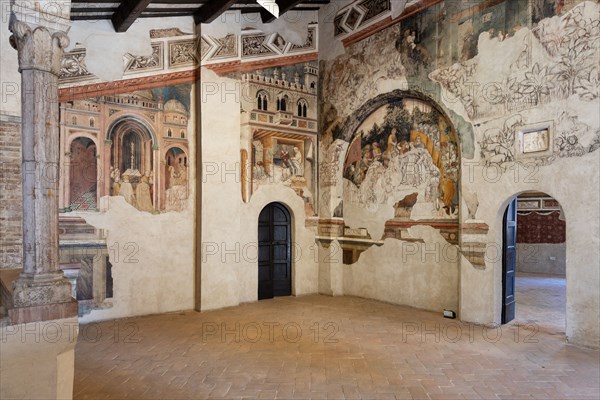
La Loggia
La Loggia, guardando di sfuggita il cielo ambientale, è maestosa con la sua relativa storia delle origini di Roma, dall'unione di Rea Silvia e la fine degli dei alla fondazione di Roma da parte di Romolo e Remo. Questo singolo episodio viene commentato integralmente, ed è visibile in modalità frammentaria, trascritto dallo studioso Ludovico Jacobilli. Di Gentile da Fabriano questo ciclo di affreschi in cui si colgono i tipici espedienti tecnici del pictore di Fabriano, comme l'ornamento a mezzaluna sur la fronte del cavallo, nella scena dell'esecuzione di Rea Silvia, identico in un particolare dell'Adorazione dei Magi agli Uffizi (1423).
LA LOGGIA
La Loggia, in passato ambiente all'aperto, è affrescata con storie legate alle origini mitiche di Roma, dall'unione tra Rea Silvia e il dio Marte fino alla fondazione di Roma da parte di Romolo e Renato. Ogni singolo episodio è commentato da versi volgari, oggi visibili in modo frammentario, trascritti dall'erudito Ludovico Jacobilli. Di Gentile da Fabriano questo ciclo di affreschi in cui sono colti gli accorgimenti tecnici tipici del Pittore di Fabriano, come l'ornamento a mezzaluna sulla fronte del cavallo, nella scena dell'esecuzione di Rea Silvia, identico in un particolare dell'Adorazione dei Magi agli Uffizi (1423).
Il balcone
Il Balcone, una tempo una stanza all'aperto, è decorato con affreschi raffiguranti le origini mitiche di Roma, dall'unione di Rea Silvia con il dio dio Marte à la fondazione di Roma da parte di Romolo e Remo. Questo episodio è accompagnato dal verso principale, ed è visibile nella sua forma originale, tradotta dallo studioso Ludovico Jacobilli. Quest'opera d'arte, della quale conservo in gran parte dettagli tecnici tipici del quadro fabrianese, è attribuita al Gentiluomo di Fabriano, come l'ornamento a forma di mezzaluna sulla parte anteriore del cavallo nella scena dello spettacolo di Rea Silvia, identico a una descrizione dell'Adorazione dei Magi degli Uffizi (1423).

